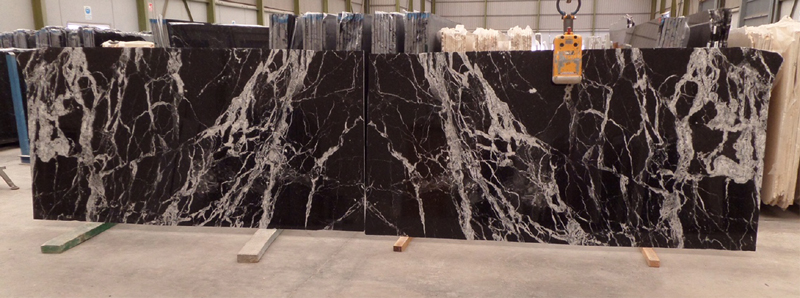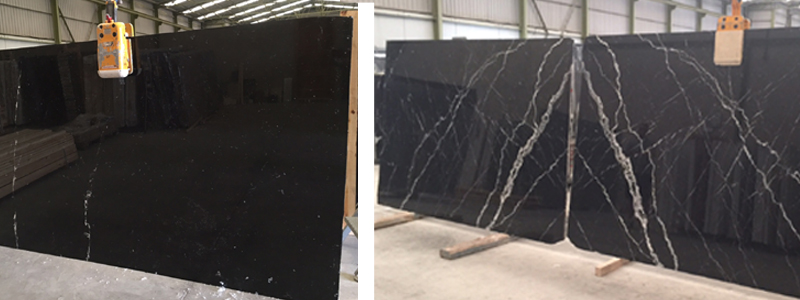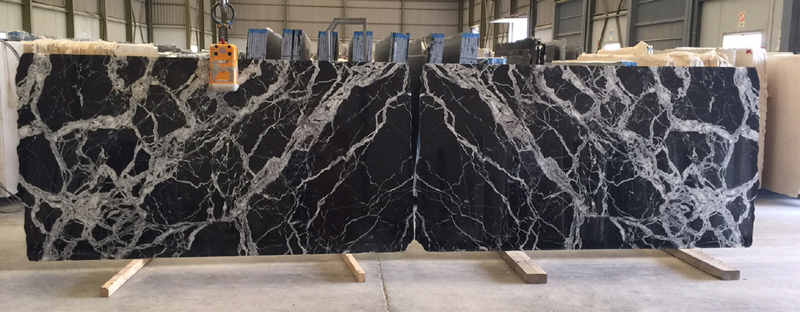The marble denominated Negro Marquina is one of the Spanish ornamental rocks most known internationally along with Crema Marfil, Marron Emperador, Rojo Alicante, to name just a few. For this very reason, there are some companies who, using the prestige of this unique material, commercialize the material of their quarries under the same name- Negro Marquina (sometimes also spelled as Negro Markina).

Location of quarries of Negro Marquina
First thing first, the original- Negro Marquina quarries are located in Spain. These quarries are located in the Basque Country, in the area of Markina, thus its name. There are three distinct quarries that are currently active (as of end of 2015).
Similar looking materials are also quarried in Morocco and Mexico, but, according to the professionals who deal with this material, when you consider material strength, size of blocks, the shine obtained… the original Negro Marquina remains unique. Similar looking limestone is also found in China, where local companies sell their material by the name of Negro Marquina. At first sight, they may indeed look quite similar. Those processing the Spanish material claim that their processing and obtaining of polish is superior, and the Chinese black material tends to have more cracks and thus there is more wastage.
Varieties of marble Negro Marquina
The real Negro Marquina, which in the beginning was known as Negro Bilbao or Negro Español, is a ornamental limestone with a very fine grain and is very compact, re-crystalized, with a black background and with abundant white veins of calcite and which contains rests of fossils of grey colour in different shades. The uniqueness of this material also lies in the fact that there are no two blocks that are the same which means every slab is unique, this reinforcing its special charm.
While different companies may employ different names to try to differentiate their variety of Negro Marquina, basically Negro Marquina comes in the following varieties:
(1) With few white veins
(2) With medium amount of veins
(3) with lot of veins.


The extraction is done in blocks of big dimensions and the sizes are not uniform, but blocks of between 2.4 to 3 m length, 1.4 to 2 m height and 1.5 m thickness tend to be more common. The slabs size, related to the size of the blocks, thus tend to be of these dimensions and there is no problem in obtaining the size of the thickness. The total production of this exclusive material is approximately 10000 sqm per month.
Applications
Negro Marquina is used mostly for interiors and also used sometimes for exteriors. The polished and honed finishes are used mostly for interior pavements, floors, walls, steps, counter-tops and washbasins. In the floorings it is usually combined with Blanco Carrara or Blanco Macael or other white limestone for the very attractive contrast that results. The most common application is, however, in the walls. The bush hammered finish is common in the Basque Country and is used for exterior pavements and in dry stone walling and facades in buildings. The flamed finish is not used. In the Basque Country, the material has been used in format of big blocks as reefs and breakwaters.
Markets
Negro Marquina enjoys wide acceptance all over the world, it is exported to different countries in Europe, United States, Canada and the Arab countries.
Maintenance
Negro Marquina has areas of carbon. In floors where there is lot of humidity, the shine is sometimes lost over time as a consequence of decomposition of carbon. To avoid this problem one needs to give the material anti-humidity treatment. If the shine is lost, one can polish the floor again.
Technical characteristics of marble Negro Marquina
- Density: 2.69 gr/cm3
- Absorption coefficient: 0.17%
- Porosity: from 0.2% to 0.47%
- Resistance to compression: 629 Kg/cm2
- Resistance to flexion: from 14.4 Mpa to 13.33 Mpa
- Resistance to wear: 2.90 mm
- Resistance to impact: 30 cm
- Microhardness to impact: 1333,33 Mpa
- Resistance to abrasion: from 19.8 to 21.5 mm
- Elasticity module variation after frost: 8,2%
Our thanks to Juan Carlos Azorín for the information provided.
Sections
